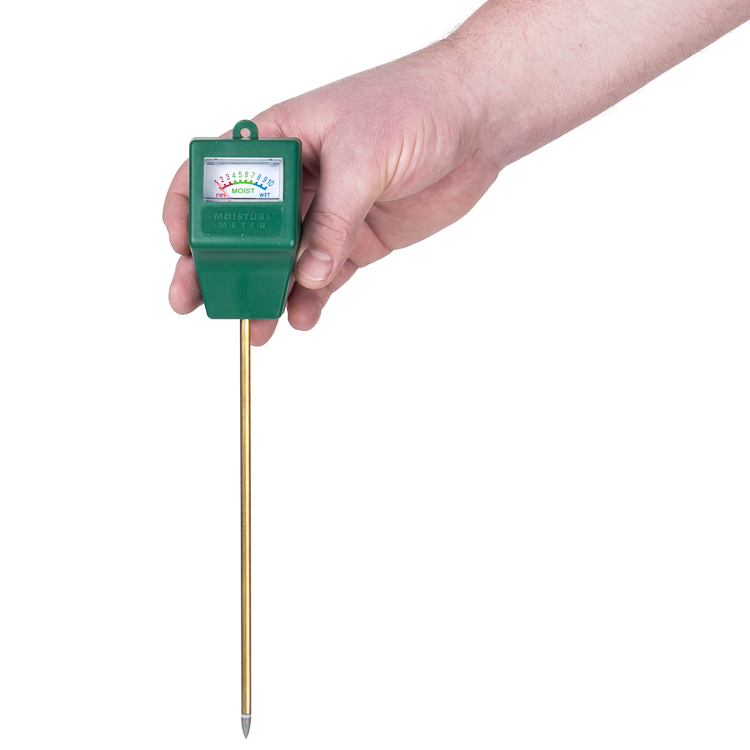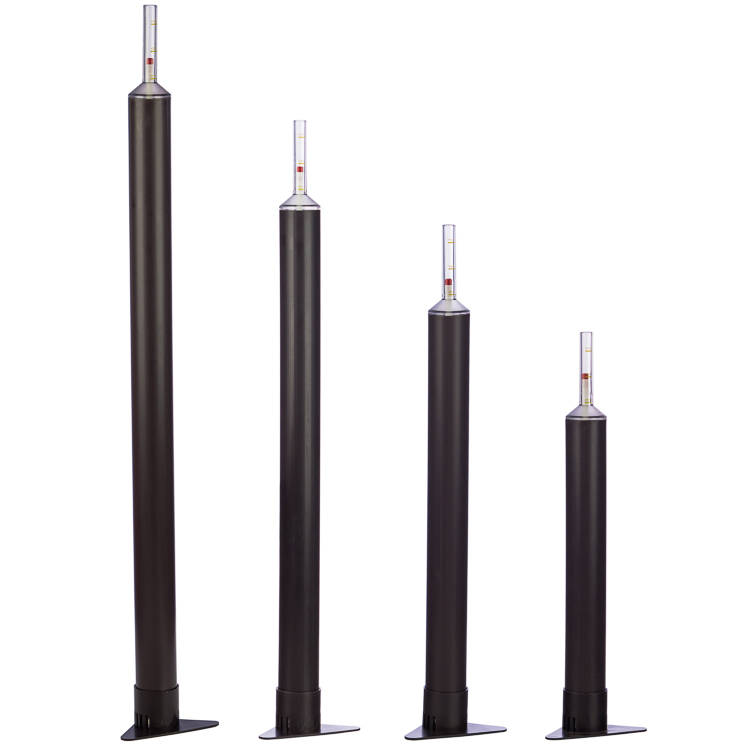Om je kamerplanten van de juiste hoeveelheid water te voorzien, is het raadzaam om gebruik te maken van een vocht- of watermeter. Met een watermeter kun je eenvoudig zien wanneer je plant weer water nodig heeft of wanneer je beter even kunt wachten.
Er zijn verschillende soorten watermeters te koop, maar hoe kies je nu de beste voor jouw kamerplant? Hieronder vind je een uitleg met de mogelijkheden.
Analoge vochtmeter

De analoge vochtmeter bestaat uit een lange pen die je in de grond kunt steken. Nadat je de pen van de vochtmeter in de kluit hebt gedrukt, kun je direct op het display het resultaat van je meting aflezen. De meter geeft direct aan of de grond droog, licht vochtig of nat is en op die manier kun je eenvoudig bepalen wanneer het tijd is om water te geven aan je kamerplant.
Deze vochtmeter kun je voor al je kamerplanten gebruiken die in de aarde staan. De meter kan gebruikt worden in potten tot een diepte van ca. 40 cm, daarna neemt de betrouwbaarheid van je meting af. En niet onbelangrijk, je hebt geen batterijen nodig en hij kan gebruikt worden voor alle kamerplanten.
Via bol.com bestel je eenvoudig een
Analoge vochtmeter »
Tekst gaat verder onder de video..
Na gebruik dien je de pen van de vochtmeter even met een doekje schoon te vegen. Ook als je meerdere planten wilt meten, dien je tussendoor de vochtmeter even schoon te maken. Op die manier voorkom je dat eventuele ziektes overgebracht worden van plant op plant.
Watermeter Zeoponic/ Hydrocultuur

De watermeters voor de Zeoponic/ hydrocultuur werken middels een vlottertje. In feite is het een buisje met een diameter van ca. 4 cm welke je met de voet vlak op de bodem van je plantenbak zet. Op het moment dat er water op de bodem staat, begint de vlotter te drijven en zal het rode puntje boven in het venster omhoog komen.
Er zijn een aantal zaken waar je wel even rekening mee dient te houden bij deze watermeter. Zo dient de voet van de watermeter plat op de bodem van je plantenbak te staan, om zo een goede meting te kunnen garanderen. Daarnaast heeft de watermeter een diameter van ca. 4 cm, dit betekend dat de watermeter ook langs de kluit van je plant loopt. Heeft jouw plant een kweekpot van 20 cm en wil je deze watermeter gebruiken, waarbij de plant in het midden van je plantenbak blijft staan, dan zal je nieuwe plantenbak minimaal 28 cm (weerszijde +4 cm) in doorsnede moeten zijn.
Kies de juiste lengte:
Watermeter 30 cm Watermeter 40 cm Watermeter 50 cm Watermeter 60 cm
Tekst gaat verder onder de video..
Analoge vochtmeter voor kleine en middelgrote kamerplanten
Voor kamerplanten met een kluit van potgrond en een kweekpot tot ca. 30 cm raden we aan om gebruik te maken van een analoge vochtmeter. Ook als je jouw kamerplant hebt opgemaakt met Zeoponic i.p.v. potgrond. Je meet namelijk in de kluit van de plant zelf en niet in de Zeoponic.
Watermeter voor grote kamerplanten en hydrocultuur
Heeft jouw plant een pot die dieper is dan 40 cm? Dan kun je het beste overstappen naar een Zeoponic watermeter. Heb jij een plant op hydrocultuur? Ook dan gebruik je deze Zeoponic watermeter.
Hoeveel water moet ik geven aan mijn kamerplant?
Dit is een vraag die we zeer vaak krijgen, maar waar geen kant-en-klaar antwoord voor is. Zo speelt de ruimtetemperatuur, het seizoen, de standplaats, afmeting van de plant en luchtvochtigheid bijvoorbeeld een grote rol in de hoeveelheid vocht die een kamerplant nodig heeft. Dit is ook precies de reden waarom we adviseren om een analoge vochtmeter of watermeter te gebruiken.
In het voorjaar en de zomer maken de meeste planten nieuw blad aan en stijgt de hoeveelheid licht die ze ontvangen. Op dat moment zal de plant ook meer water gaan vragen. Na de zomer zal de hoeveelheid water die jouw kamerplant nodig heeft weer langzaam afnemen. Vanaf het najaar gaan de meeste planten in rust en is er minder water nodig.
Op onze
verzorgingspagina staan vrijwel alle soorten kamerplanten vermeld, daar kun je dus per plant opzoeken of jouw kamerplant graag droog, licht vochtig of nat staat.
Meten is weten
Helaas zien we nog te vaak dat er uit enthousiasme te veel water wordt gegeven aan planten. Gevolg is dat na verloop van tijd de grond verzadigd en er water op de bodem van de plant blijft staan. Dit heeft als gevolg dat wortels kunnen gaan rotten en je plant langzaam dood gaat.
Meten is weten en laat je zeker niet verleiden door de kleur van de grond aan de bovenzijde. Water zakt namelijk naar onderen, dus oogt en voelt de grond bovenop in de pot nog droog, dan kan deze onderin de pot nog kletsnat zijn.
Geef je kamerplant geen koud water
Als je jouw planten water gaat geven, zorg dan dat het water op kamertemperatuur is. Geef je koud kraanwater, dan loop je het risico dat de wortels dichtslaan. Daarnaast zijn sommige kamerplanten ook gevoelig voor kalkrijk water. Mocht je erg veel last hebben van kalkrijk water, dan kun je ook het water eerst koken of gebruik maken regenwater.
Vergeet je planten ook niet af en toe nat te sproeien
De meeste kamerplanten komen van oorsprong uit een tropische omgeving, dit betekend dat ze gewend zijn aan een hoge luchtvochtigheid. In onze woonkamer of op kantoor is de luchtvochtigheid vaak een stuk lager, waardoor bladeren soms bruine randen en/of bladpunten kunnen krijgen. Maar ook opkrullende bladeren kunnen wijzen op een te lage luchtvochtigheid. Besproei je planten daarom regelmatig met een plantspuit, zo blijven de bladeren van je kamerplant langer mooi.
 De analoge vochtmeter bestaat uit een lange pen die je in de grond kunt steken. Nadat je de pen van de vochtmeter in de kluit hebt gedrukt, kun je direct op het display het resultaat van je meting aflezen. De meter geeft direct aan of de grond droog, licht vochtig of nat is en op die manier kun je eenvoudig bepalen wanneer het tijd is om water te geven aan je kamerplant.
De analoge vochtmeter bestaat uit een lange pen die je in de grond kunt steken. Nadat je de pen van de vochtmeter in de kluit hebt gedrukt, kun je direct op het display het resultaat van je meting aflezen. De meter geeft direct aan of de grond droog, licht vochtig of nat is en op die manier kun je eenvoudig bepalen wanneer het tijd is om water te geven aan je kamerplant. 
 De watermeters voor de Zeoponic/ hydrocultuur werken middels een vlottertje. In feite is het een buisje met een diameter van ca. 4 cm welke je met de voet vlak op de bodem van je plantenbak zet. Op het moment dat er water op de bodem staat, begint de vlotter te drijven en zal het rode puntje boven in het venster omhoog komen.
De watermeters voor de Zeoponic/ hydrocultuur werken middels een vlottertje. In feite is het een buisje met een diameter van ca. 4 cm welke je met de voet vlak op de bodem van je plantenbak zet. Op het moment dat er water op de bodem staat, begint de vlotter te drijven en zal het rode puntje boven in het venster omhoog komen. 